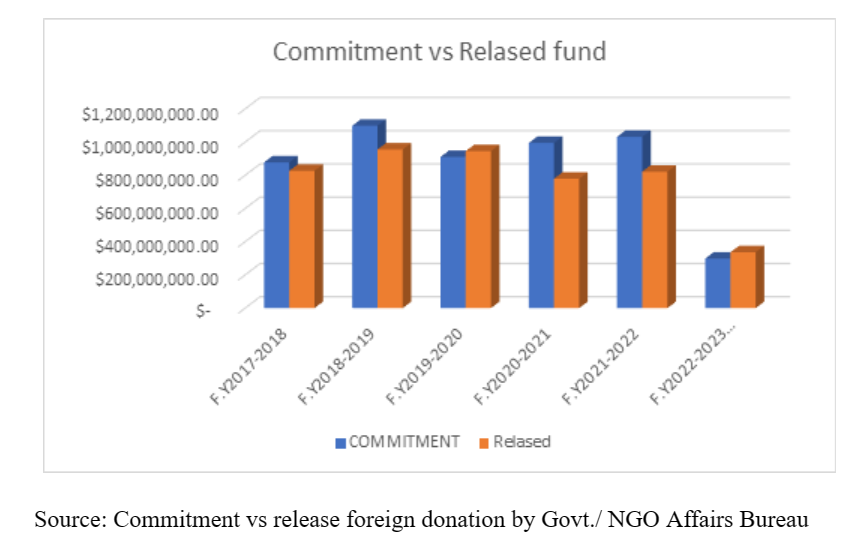Written by: Sajjad Hosen
Introduction
Foreign donations refer to the financial or in-kind contributions made by individuals, organizations, or governments from other countries to support the development or humanitarian projects in a recipient country. These donations can take various forms, such as grants, loans, technical assistance, and emergency aid. Foreign donations can play a significant role in supporting the development and economic growth of recipient countries, particularly in low-income or crisis-affected areas. Currently, Bangladesh has the world’s largest refugee camp in Cox’s Bazar which is dependent on foreign donations by different governments or organizations.
Bangladesh is a densely populated country in South Asia with a developing economy. Despite facing challenges such as political instability, corruption, and natural disasters, Bangladesh has made significant progress in reducing poverty and improving economic growth over the past few decades. The country has a mixed economy, with agriculture being the largest sector, followed by industry and services. The major agricultural products include rice, jute, tea, wheat, sugarcane, and vegetables. The country’s industrial sector includes textiles and garments, pharmaceuticals, leather goods, ceramics, and shipbuilding. The service sector is dominated by the banking and financial sector, telecommunications, and transportation.
However, Bangladesh still faces many economic challenges, such as inadequate infrastructure, high population growth, income inequality, and a lack of investment. As a result, the country is heavily dependent on foreign aid and remittances from migrant workers to sustain its economic growth. Foreign donations have been an important source of support for Bangladesh’s economic and social development for many years. The country has received foreign aid from a variety of sources, including bilateral donors, multilateral institutions, and international organizations.
Overview of Foreign Donations in Bangladesh
During the FY 2019-20, the Foreign Assistance Collection Programme received a total commitment of USD 9.724 million. This amount includes a grant of USD 502.28 million and a loan of USD 9222.14 million. The original target for foreign assistance commitment was set at USD 6000.00 million, which was exceeded by 162.07%. Among the multilateral development partners, the ADB provided the highest foreign assistance commitment of USD 1798.86 million during this fiscal year(ERD,2020). The largest donors during this period were the World Bank, the Asian Development Bank, the Japan International Cooperation Agency, and the United States.
Foreign donations have played a critical role in supporting a range of development projects in Bangladesh, including infrastructure development, poverty reduction, health and education, and disaster response. For example, foreign aid has been used to finance projects such as the construction of roads, bridges, and ports, the provision of clean water and sanitation, and the expansion of healthcare and education services.
Types of foreign donations received by Bangladesh
Bangladesh receives various types of foreign donations to support its economic and social development. These donations can be broadly categorized into two types:
1) Grants: These are financial contributions made by foreign governments, international organizations, or private donors that do not need to be repaid. Grants are often used to fund humanitarian and development projects in areas such as health, education, infrastructure, and disaster relief.
2) Loans: These are financial contributions made by foreign governments, international financial institutions, or private lenders that must be repaid with interest over a period of time. Loans are often used to fund large-scale infrastructure and development projects.
In addition to these two types, Bangladesh also receives technical assistance from foreign donors. Technical assistance includes expertise and training in areas such as agriculture, public health, and governance, to support the development of these sectors in Bangladesh.
Sources of foreign donations
The sources of foreign donations to Bangladesh are diverse, and they can be broadly classified into the following categories:
1) Bilateral donors: These are foreign governments that provide assistance to Bangladesh on a government-to-government basis. Examples include the United States, the United Kingdom, Japan, and China.
2) Multilateral institutions: These are international organizations that provide assistance to Bangladesh in collaboration with multiple member countries. Examples include the World Bank, the Asian Development Bank, and the United Nations Development Programme.
3) Non-governmental organizations (NGOs): These are private organizations that provide assistance to Bangladesh on a non-profit basis. Examples include Oxfam, CARE, and Save the Children.
4) Private donors: These are individuals, corporations, and foundations that make financial contributions to support specific projects or causes in Bangladesh. Examples include the Bill and Melinda Gates Foundation and the Ford Foundation.
Benefits of Foreign Donations in Bangladesh
Foreign donations can bring a range of benefits to Bangladesh, such as Supporting economic development, Addressing poverty, Disaster relief, Promoting education, Supporting health initiatives, and Encouraging social and environmental sustainability. Overall, foreign donations can play an important role in helping Bangladesh address its development challenges and improve the well-being of its people. Also, its contribution to economic growth in Bangladesh in several ways, including foreign donations can be used to finance the construction of infrastructure such as roads, bridges, and ports, which can help to facilitate trade, increase productivity, and attract investment.
Foreign donations Support small businesses, promote education and skills development & Improving healthcare. Foreign donations can help to create a favorable environment for foreign investment by improving infrastructure, enhancing the skills of the workforce, and promoting economic stability and sustainability.
Statistics of foreign donation
Bangladesh heavily relied on foreign aid since its independence in 1971, receiving about $69 billion in grants and loans between 1971-2016. Although reliance on foreign aid has reduced over the years, a significant portion of the country’s development budget still comes from external assistance. However, debates persist over the effectiveness of foreign aid and its contribution to a country’s progress or development success. Measuring the impact of foreign aid is challenging as development programs draw funding from multiple sources, and aid can have unintended consequences, such as impeding a country’s economic growth and causing Dutch disease. Donors need to consider multiple dimensions of aid effectiveness when providing aid to developing countries (Huq, 2023). The World Food Program has reduced food aid to Rohingya refugees due to the global economic crisis caused by the Russia-Ukraine conflict. Bangladesh and the United Nations will appeal for $876.50 million in humanitarian aid for the Rohingya refugees at a meeting of development partners in Geneva, to prevent the international community’s attention from shifting away from the Rohingya crisis. The UNHCR and IOM have initiated the meeting, scheduled for March 7, 2023(Prothom Alo,2023).

Bangladesh Government released $336,723,784.81 in the FY 2022-23(up to Dec ’22), this amount is only released by NGOAB(NGOAB,2023). Besides the amount, Bangladesh Govt received a huge amount of donations from UN Agencies which is directly implemented for the development of Bangladesh. The amount is drastically reduced nowadays due to the global economic crisis and other emergency responses around the world such as in the Turkey & Syria Earthquake, Ukraine Response and many more. In the last six fiscal years, Bangladesh Govt released a total of USD 4.67 in foreign donations to different organizations.
Conclusion:
Finally, foreign donations play a significant role in the development of Bangladesh’s economy. These donations come from a variety of sources, including bilateral donors, multilateral institutions, NGOs, and private donors. Foreign donations have had a positive impact on Bangladesh’s economy, helping to reduce poverty, improve living standards, and promote economic growth. They have also enabled the country to invest in key areas, such as infrastructure and education, that are critical for long-term development. However, there are also challenges associated with foreign donations, such as the risk of dependence and the need for effective management and coordination. To maximize the benefits of foreign donations, it is essential that they are used in a strategic and sustainable manner, with a focus on building local capacity and promoting self-reliance.
References:
- ANNUAL REPORT 2019-2020, Economic Relations Division(ERD,2020), Ministry of Finance p-6, https://erd.portal.gov.bd/sites/default/files/files/erd.portal.gov.bd/page/b59253d3_9b61_4877_b8a8_747a3d99eb87/Annual%20Report%202019-2020%20(1).pdf
- Huq, Z. (2023, March 16). Getting the priorities right. The Financial Express. https://thefinancialexpress.com.bd/views/opinions/getting-the-priorities-right
- Prothom Alo (2023, March 6). Bangladesh wants global attention not to shift from Rohingya crisis. Prothomalo. https://en.prothomalo.com/bangladesh/h6y1f55xpw
- NGOAB Statistics 2023, NGO Affairs Bureau https://ngoab.portal.gov.bd/sites/default/files/files/ngoab.portal.gov.bd/page/5b6a31b2_679b_485e_8c68_5cd295eb7d7d/2023-02-20-09-22-350eecd8c3dedd448015be2d4b8e12c6.pdf
Featured Image Courtesy: Lawnn
